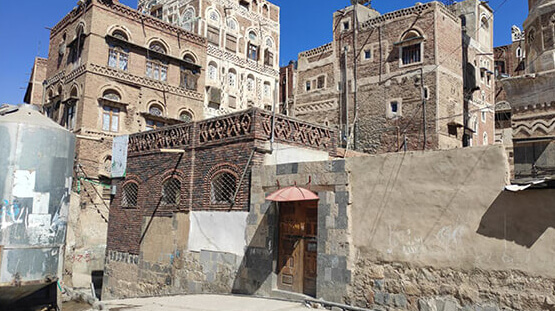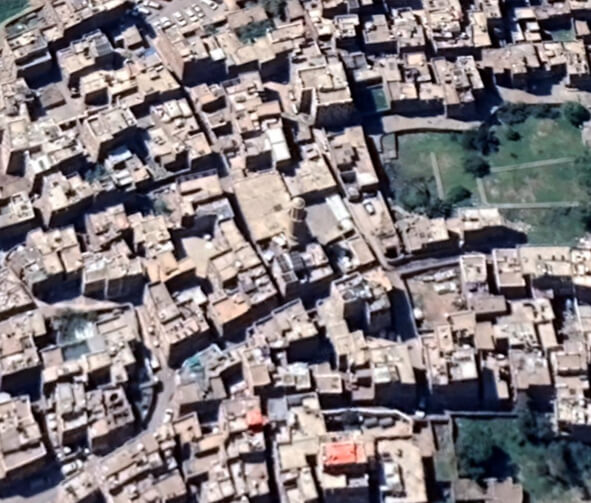
Ibn Al-Ḥusayn Mosque – Old Ṣan‘ā’
مسجد ابن الحسين- صنعاء القديم ة
Monument description
Al-Hajri in his book tells two narrations about who built it, citing in the first narration what he saw from the handwriting of Judge Abd Al-Malik Ibn Husayn Al-Ansi in a collection with his grandson, Judge Ahmed Ibn Muhammad Abd Al-Malik. This is from the building of Al-Husayn Ibn Salama, the mawla of Bani Ziyad Muluk, Zabid, at the end of the 4th century AH. The second narration is that it is one of the works of Imam Al-Mahdi Ahmed Ibn Al-Hussein Ibn Ahmad Ibn Al-Qasim Ibn Abdullah Ibn Al-Qasim Ibn Ahmad Ibn Ismail Ibn Ibrahim Ibn Al-Hasan Ibn Al-Hussain Ibn Amir Al-Mu’minin Ali Ibn Abi Talib, may God be kind to him. Al-Hajri gathers in the two narrations that the first was established and the second was renewed. This is one of the full-blown mosques in the Old City of Sana‘a.

Architectural and cultural value
Construction style and built date: The layout of the Mosque came in the style of mosque planning, which consists of a Prayer Hall, with a flat roof built with wooden beams resting directly on the capitals of stone columns and arches; much has been changed in it. It is from the building of Al-Hussein bin Salamah, the mawla of Banu Ziyad, kings of Zabid in the late 4th century; the second narration is that it is from the works of the Imam Al-Mahdi Ahmed bin Al-Hussain bin Ahmed bin Al-Qasim bin Abdullah bin Al-Qasim bin Ahmed bin Ismail bin Ibrahim bin Al-Hassan bin Al-Hussain bin the Commander of the Faithful Ali bin Abu Talib, may God honor him.
- Justifications for intervention:
- 1-Neglecting the competent authorities in carrying out periodic restoration work due to the lack of budgets for the repairs.
- 2-Preserving the monument from disappearance and stopping the damage caused to the monument from expanding.
- 3-Restoration of the damage to the mosque resulting from the flight strikes of the southern part of the old city of Sana’a.
- 4-Contribute to the restoration of damaged monuments in a proper manner in order to keep Old Sana’a on the World Heritage List.
- Monument conditions and treatments:
- The monument is generally in good preservation condition, however there are some obvious signs of damage that need urgent intervention to maintain the monument:
- 1. Salt and erosion in the foundation stones in the southeast corner of the prayer house
- 2. The erosion of the salinity of the southern wall of the purifiers.
- 3. A total collapse of a well and Al-Murna, southwest of the mosque
- 4. Vertical cracking of the brick wall of the Snidar House, the mosque’s northern facade
- 5. A slight dent in the foundations of the western facade of the House of Prayer
- 6. Leakage of rain water from the exposed surface of the purifiers.
- 7. Rain water leakage from the water supply part of the southeast corner.
- 8. Cracks in the roof of the concrete prayer house
- 9. Broken wood in two steps of the minaret staircase
- 10. A slight crack in the water supply of the northern facade of the House of Prayer.
- 11.Cracks and cracks of the turkey stone in the body of the minaret from the west.
- Treatment and restoration:
- – Remove and rebuilding of the damaged parts from the different sectors of the Mosque, and using materials identical to the old ones, as bricks, stones or others
- – Stopping the vertical expansion of cracks in the affected facades by inserting pieces of wood that limit the vertical expansion of these cracks
- – Cleaning the decorative inscriptions in the different parts of the Mosque, removing the oil paint, completing any dilapidated parts and deducing them through the decorations adjacent to them
- – Restoration of Qudad layers in various areas of the Mosque and completing the missing parts of it
- – Completing the dilapidated parts of the pool and repairing cracks on the Qudad layers on the floor or sides of the pool.

Countries










